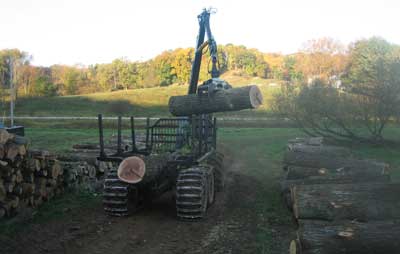What Loggers Do
How do I work with a logger?

Loggers are in the business of bringing forest products to market through cutting trees, removing logs from woodlands, and hauling them to mills for processing. They may operate independently or be employed by a mill.
Loggers use chainsaws and/or processors to fell trees; skidders (with a cable or grapple) to haul logs out of the woods; and logging trucks to transport logs to mills.
Typically, high-quality logs are hand-felled and cut to length using chainsaws to maximize economic value. High-volume products, like pulp, are usually harvested using mechanized equipment like a processor.
What you should expect
During timber harvesting, woodland owners should expect that loggers:
- Maintain company bonding: i.e., have a business license and proper insurance, and are protected with bond against financial losses
- Know and will respect property boundaries
- Are familiar with existing laws, such as oak wilt harvesting restrictions and seasonal road weight limits
- Know which trees to harvest; that is, they will harvest marked trees and protect unmarked trees from damage
- Understand your objectives both during the harvest and post-harvest. For example, logging roads, harvest methods, tree slash management should all be considered against landowner goals
- Will provide and sign a timber harvesting contract
The Wisconsin Master Logger Certification Program recognizes logging companies that meet sustainable forest management standards set forth by the American Loggers Council.
